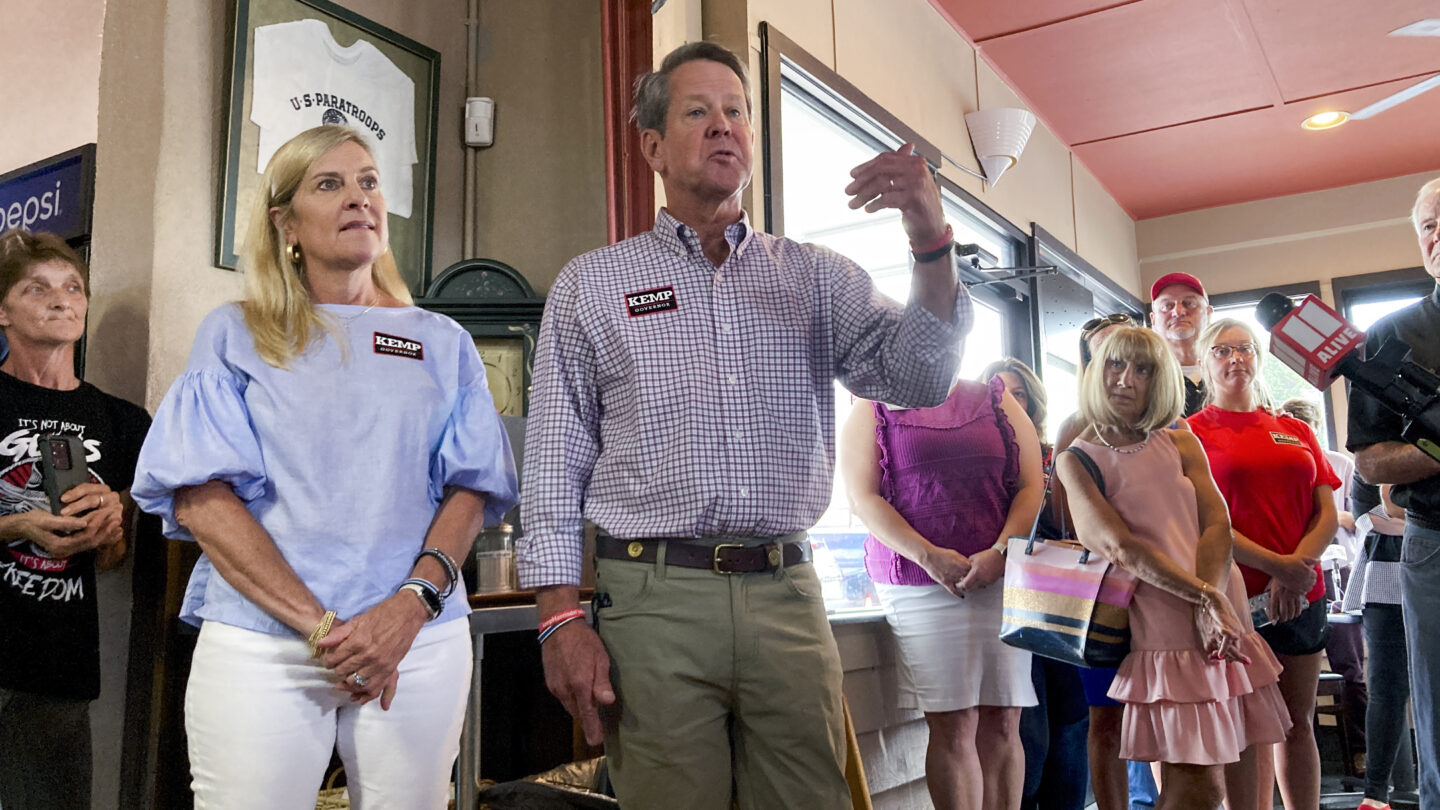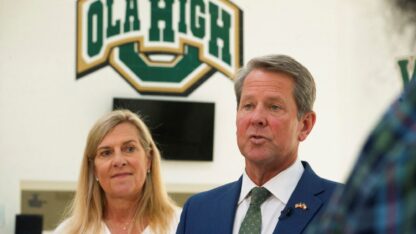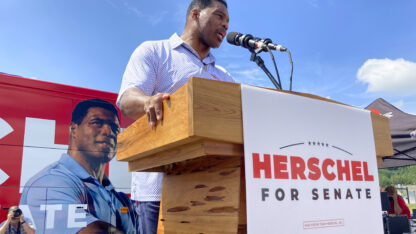When Georgia Gov. Brian Kemp made one of his first general election campaign swings in August, he went straight to the modern heartland of the state’s Republican Party.
It wasn’t Buckhead, the glitzy Atlanta neighborhood where Kemp lives in a governor’s mansion dwarfed by other nearby estates. And it wasn’t suburban Cobb County, once the bastion of Newt Gingrich.
Instead, Kemp kept going north, deep into the Georgia mountains that have become one of the most Republican areas in the country over the last three decades. He stopped at a gas station turned coffee shop in Toccoa to urge people to “turn out an even bigger vote here in this county and in northeast Georgia than we’ve ever seen before.”
“Ask your kids, your grandkids, your friend’s kid, are they registered to vote?” Kemp told attendees. “If they’re eligible, and they’re not, we got to get them registered, and we’ve got to go tell them to pull it for the home team.”
The emphasis on this rural region represents a notable shift in the GOP’s strategy in Georgia. The party grew into a powerhouse in Georgia once it began combining a strong performance in the Atlanta suburbs with growing dominance in rural areas. But that coalition has frayed in recent years as voters in the booming Atlanta region rejected the GOP under former President Donald Trump, turning this onetime Republican stronghold into the South’s premier swing state.
A 41-county region, including some distant Atlanta suburbs encroaching into north Georgia, now has as many GOP voters as the core of metro Atlanta, according to an analysis by The Associated Press. Those changing dynamics have intensified pressure on Kemp to maintain — or strengthen — his support in rural mountainous communities like Toccoa to offset losses closer to the capital city.
“The party … in terms of understanding where they’re going to get votes, understands that now they need those votes in north Georgia to compensate for their losses in the suburbs,” said Bernard Fraga, an Emory University political scientist.
Kemp won the governor’s office in 2018 by defeating Democrat Stacey Abrams by just 1.4 percentage points. As the two wage a rematch for the post this year, early summer polling found a close race, with some suggesting Kemp has a narrow advantage.
But his reliance on voters like those in Toccoa is driving the party further to the right.
In a diversifying state, north Georgia is overwhelmingly white. While Democrats attack and Republicans fret over abortion restrictions in the suburbs, there’s little public wavering in the mountains. Voters love guns so much that they cut out the middleman and chose gun dealer Andrew Clyde as one of north Georgia’s two very Trumpy members of Congress. The other member? Marjorie Taylor Greene.
“It reflects a lot of the country right now, in the sense that it’s very populist, very close to the vest, very isolated in the sense of distrust of government, very strong-willed, mountain Appalachian-type individuals that are very self sufficient,” said former Rep. Doug Collins, the Republican who preceded Clyde in representing northeast Georgia’s 9th Congressional District.
Kathy Petrella, a Clarkesville retiree who was visiting the state Department of Driver Services in early September in Toccoa, said she’s a “true blue conservative.”
“It means I don’t believe in the government telling me anything I have to do, except law and order,” said Petrella, who cites her Christian faith as an important anchor of her political affiliation and fears a decline into “communism.”
Lee MacAulay of the north Georgia town of Cleveland, also visiting Toccoa, said she believes Trump won the 2020 election and calls President Joe Biden “a ridiculous joke” and “an idiot.”
“I was a Trumper,” MacAulay said. “I am a Trumper.”
She discounts the idea that lingering doubts about the 2020 election will suppress turnout as they appeared to do in the 2021 Senate runoff elections, when victories by Democrats Raphael Warnock and Jon Ossoff gave their party control of Congress. MacAulay said she believes many neighbors are eager to vote for Republicans this year, “but we need everybody.”
Jay Doss, a Toccoa lawyer, said he feels “working-class people are benefited more by the conservative party” and that “I just feel that less government is better for everybody.”
There was once another conservative tradition in north Georgia — in the Democratic Party. While there were always some Republicans, a legacy of white mountaineers who backed the Union over the Confederacy in the Civil War, they won few elections.
“It used to be … if you ran Republican, you could not get elected. Now, if you run Democrat, you ain’t got a chance much of getting elected,” said Stephens County Commissioner Dennis Bell, a Republican who owns Currahee Station, the coffee shop where Kemp campaigned in Toccoa.
That Democratic lineage, nourished by the 1930s-era New Deal, produced former Gov. Zell Miller, a proud son of the mountains and titan of Georgia Democratic politics a generation ago.
Miller rode high in the 1990s as a Democrat who combatted crime and overhauled welfare, while creating lottery-funded college scholarships. Miller even squeaked out a reelection victory in the 1994 “Republican Revolution” that vaulted Gingrich to U.S. House speaker.
That year, Miller actually lost his home region to Republican Guy Millner, a self-financed millionaire businessman. But Miller lost by fewer than 4,000 votes across north Georgia, and Millner’s strength in suburban Atlanta wasn’t enough, leaving the Republican 32,000 votes short statewide.
By 2004, as a U.S. senator, Miller was giving the keynote speech at the Republican National Convention that renominated George W. Bush. By then, Miller had written “A National Party No More,” a book that blamed his own party for abandoning Southern conservative Democrats.
“Obviously, southerners believe the national Democratic Party does not share their values,” Miller wrote in the 2003 book. “They do not trust the national party with their money or the security of the country.”
North Georgia was 19% of Millner’s vote in 1994. It was 26% of Kemp’s vote in 2018. Some of that is due to population growth, but reflects a partisan shift to Republicans. Millner won less than 51% of the vote in the region. Kemp won almost 72%.
Democrats, enduring steep decline, grew demoralized. June Krise, who then chaired the Democratic Party in north Georgia’s White County, remembers crying when the county probate judge, clerk of court and sheriff all switched to run as Republicans.
“‘If we don’t switch, we will lose because the Republicans are going to run somebody against us,'” Krise remembers the men telling her. “And guess why they were going to lose. Barack Obama was the Democratic nominee for president.”
Republicans say formerly Democratic voters gravitated to their party because of cultural issues, but those who study the electorate note white voters are much more likely to be Republican, and Appalachia made a hard turn against Obama, the nation’s first Black president.
“The Republican Party has now started organizing itself, I think, to be more in line with the white people who are there — more rural, less urban-interested, even less suburban-interested, in terms of the state party,” Fraga said. “And that looks more like North Georgia in a lot of ways.”
Fraga sees the split in the Georgia Republican Party over Trump’s attempt to overturn Joe Biden’s 2020 presidential victory in Georgia in part as a conflict between suburban and rural. Suburban-identified politicians including Secretary of State Brad Raffensperger were willing to oppose Trump, Fraga said, while Republicans representing more rural areas, such as Greene, were “on the Trump train.”
Democrats have been trying to rebuild. Mike Maley, a Toccoa pediatrician who chairs the Stephens County Democratic Party, says just getting people on the ballot helps get the message out.
“I have hope for our community,” Maley said. “I feel like we can make a difference and this is worth fighting for.”
Democrats note that even if they’re not going to win in places like Stephens County, where more than 80% of voters chose Kemp in 2018 and Trump in 2020, each additional vote counts in Georgia’s ultra-close statewide elections. That’s what brought Abrams to the mountain town of Clayton on July 28.
“Why would you go there?” Abrams told Rabun County Democrats she was asked about her trip. “Because counties don’t vote, people do.”
Abrams’ strategy is simple. Get more Democrats to vote across the state, backed up by a campaign that sometimes seems focused more on rural areas than her home turf of Atlanta.
“We’ve got to boost turnout dramatically across the board,” Abrams said that day. “But we’ve already seen it’s possible.”
But many voters, like Bell, will be looking to Kemp and other Republicans. The Stephens County commissioner says Democrats are “going way too far to the left” and says debt, spending and restrictions on oil and gas drilling make a GOP vote in north Georgia “a no-brainer.”
Follow AP for full coverage of the midterms at https://apnews.com/hub/2022-midterm-elections and on Twitter at https://twitter.com/ap_politics








